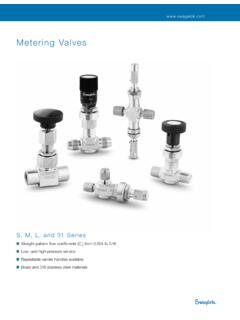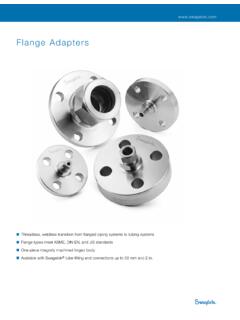Transcription of A106 Grade B CARBON STEEL
1 A106 Grade B CARBON STEEL Datasheet for A106 Grade B CARBON STEEL Pipes & Tubes Sheets & Plates Bars & Rods, Forgings Fittings & Flanges Nuts & Bolts Valves METALLICA METALS We are a metal supplier of Hastelloy, Monel, Inconel, Incoloy, Stainless STEEL , Duplex, Super Duplex, Nickel Alloys and more. Email: | Tel: +91 8928722715 | +91-22-66581538, +91-22-67436694, +91-22-66109768 1 Datasheet for CARBON STEEL A106 Grade B What is CARBON STEEL A106 Grade B? CARBON STEEL is a STEEL with CARBON content up to by weight.
2 The definition of CARBON STEEL from the American Iron and STEEL Institute (AISI) states: STEEL is considered to be CARBON STEEL when: no minimum content is specified or required for chromium, cobalt, molybdenum, nickel, niobium, titanium, tungsten, vanadium or zirconium, or any other element to be added to obtain a desired alloying effect; the specified minimum for copper does not exceed percent; or the maximum content specified for any of the following elements does not exceed the percentages noted: manganese , silicon , copper The term " CARBON STEEL " may also be used in reference to STEEL which is not stainless STEEL ; in this use CARBON STEEL may include alloy steels.
3 As the CARBON percentage content rises, STEEL has the ability to become harder and stronger through heat treating; however, it becomes less ductile. Regardless of the heat treatment, a higher CARBON content reduces weldability. In CARBON steels, the higher CARBON content lowers the melting point. CARBON STEEL A106 Grade B Product specification Product ASTM A106 Gr. B Seamless Pipes Brand Jindal, MSL, ISMT Shapes Round Types Seamless and Welded Size 1/2" to 48" Thickness SCH 40, SCH 80, SCH 160, SCH XS, SCH XXS, All Schedules Common Grades API 5L Gr.
4 B, ASTM A106 Gr. B, ASTM A333 Gr. 6, ASTM A53 Gr. B, ASTM A500 Gr. B Fittings Type Seamless Butt Weld, Flanges, Black, Galvanised Other Fittings Elbows, Tees, Reducers, Caps, Stub Ends, Flanges (ANSI, Table E, D and H) 2 Difference Between CARBON STEEL and Stainless STEEL CARBON STEEL and stainless STEEL have the same basic ingredients of iron and CARBON . Their main difference is alloy content CARBON STEEL has under percent alloy content, while stainless STEEL must contain percent chromium or more. That essential difference is what gives CARBON STEEL and stainless STEEL their distinct physical characteristics.
5 CARBON STEEL Stainless STEEL Vulnerable to rust Resistant to rust Brittle Less Brittle Wear-resistant Less wear-resistant Types of CARBON STEEL 1. Low CARBON STEEL CARBON content 2. Medium CARBON STEEL - CARBON content 3. High CARBON STEEL - CARBON content 4. Super High CARBON STEEL - CARBON content Commonly used CARBON STEEL explained below: 1. Low CARBON STEEL Plain CARBON steels - very low content of alloying elements and small amounts of Mn. Most abundant Grade of STEEL is low CARBON STEEL - greatest quantity produced; least expensive.
6 Not responsive to heat treatment; cold working needed to improve the strength. Good Weldability and machinability. High Strength, Low Alloy (HSLA) steels - alloying elements (like Cu, V, Ni and Mo) up to 10 wt %; have higher strengths and may be heat treated. 3 2. Medium CARBON STEEL CARBON content in the range of Can be heat treated - austenitizing, quenching and then tempering. Most often used in tempered condition tempered martensite. Medium CARBON steels have low hardenability. Addition of Cr, Ni, Mo improves the heat treating capacity.
7 Heat treated alloys are stronger but have lower ductility. Typical applications Railway wheels and tracks, gears, crankshafts. 3. High CARBON STEEL High CARBON steels CARBON content High C content provides high hardness and strength. Hardest and least ductile. Used in hardened and tempered condition. Strong carbide formers like Cr, V, W are added as alloying elements to from carbides of these metals. Used as tool and die steels owing to the high hardness and wear resistance property.
8 4. Super High CARBON STEEL Approximately CARBON content. Steels that can be tempered to great hardness. Used for special purposes like (non-industrial-purpose) knives, axles or punches. Most steels with more than CARBON content are made using powder metallurgy. Application of CARBON STEEL CARBON STEEL is used in boilers, pressure vessels, heat exchangers, piping, and other moderate-temperature service systems in which good strength and ductility are desired. Significant other factors include cost, availability, and the ease of fabrication.
9 4 Effects of Alloying Elements on STEEL Manganese strength and hardness; decreases ductility and weldability; effects hardenability of STEEL . Phosphorus increases strength and hardness and decreases ductility and notch impact toughness of STEEL . Sulfur decreases ductility and notch impact toughness Weldability decreases. Found in the form of sulfide inclusions. Silicon one of the principal deoxidizers used in STEEL making. In low- CARBON steels, silicon is generally detrimental to surface quality.
10 Copper detrimental to hot-working steels; beneficial to corrosion resistance (Cu> ). Nickel - ferrite strengthener; increases the hardenability and impact strength of steels. Molybdenum - increases the hardenability; enhances the creep resistance of low-alloy steels. Frequently Used ASTM Grades of CARBON STEEL CARBON STEEL Type Standard Grades specification Medium-Temp Pipes A106 A, B, C This specification covers CARBON STEEL pipe for high-temperature service. Fittings A234 WPA, WPB, WPC This specification covers wrought CARBON STEEL and alloy STEEL fittings of seamless and welded construction.




